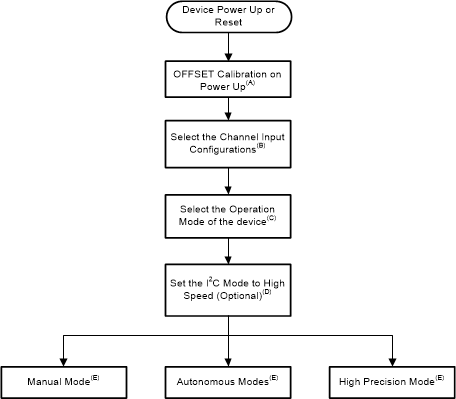SBAS891B November 2017 – September 2022 ADS7142-Q1
PRODUCTION DATA
- 1 Features
- 2 Applications
- 3 Description
- 4 Revision History
- 5 Pin Configuration and Functions
-
6 Specifications
- 6.1 Absolute Maximum Ratings
- 6.2 ESD Ratings
- 6.3 Recommended Operating Conditions
- 6.4 Thermal Information
- 6.5 Electrical Characteristics: All Modes
- 6.6 Electrical Characteristics: Manual Mode
- 6.7 Electrical Characteristics: Autonomous Modes
- 6.8 Electrical Characteristics: High Precision Mode
- 6.9 Timing Requirements
- 6.10 Switching Characteristics
- 6.11 Timing Diagrams
- 6.12 Typical Characteristics: All Modes
- 6.13 Typical Characteristics: Manual Mode
- 6.14 Typical Characteristics: Autonomous Modes
- 6.15 Typical Characteristics: High-Precision Mode
-
7 Detailed Description
- 7.1 Overview
- 7.2 Functional Block Diagram
- 7.3 Feature Description
- 7.4 Device Functional Modes
- 7.5 Programming
- 7.6 Register Map
- 8 Application and Implementation
- 9 Device and Documentation Support
- 10Mechanical, Packaging, and Orderable Information
Package Options
Mechanical Data (Package|Pins)
- DQC|10
Thermal pad, mechanical data (Package|Pins)
- DQC|10
Orderable Information
7.4 Device Functional Modes
The ADC has the following functional modes:
- Manual mode:
- Manual mode with CH0 only
- Manual mode with auto-sequence
- Autonomous modes:
- Autonomous mode with threshold monitoring and diagnostics
- Autonomous mode with burst data
- High-precision mode
The ADC powers up in manual mode with CH0 only and can be configured into one of the other modes by writing the configuration registers for the desired mode. Steps for configuring ADC into different modes are shown in Figure 7-11.

A. Offset can also be calibrated anytime during normal operation by setting the bit in the OFFSET_CAL register.
B. Configure the CH_INPUT_CFG register.
C. Configure the OPMODE_SEL register for the desired operation mode.
D. See the Section 7.3.10.4 section.
E. The operating mode is selected by configuring
the OPMODE_SEL register in step 3.
F. For reading and writing registers, see the
Section 7.5 section.
Figure 7-11 Configuring the ADC Into Different
Modes